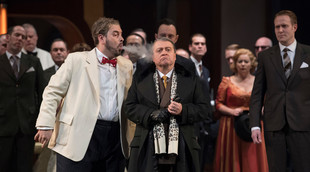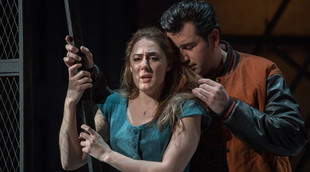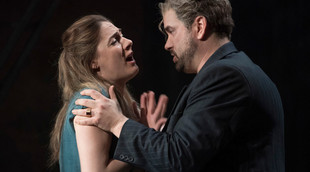 © (c) Alastair Muir
© (c) Alastair Muir
Based on Victor Hugo’s play Le roi s’amuse, Giuseppe Verdi’s Rigoletto was a triumph when it premiered at La Fenice in Venice in 1851, and has remained one of the composer’s most frequently performed operas ever since. Its popularity is thoroughly deserved but might still be deemed interesting, given that it is a contender for the cruellest opera in the mainstream repertoire. While many works see the innocent suffer and die, there is usually a sense in which virtue has triumphed if only by remaining defiant in the face of evil. In the case of Rigoletto, however, it is the character who is arguably the most wronged by life as a whole who ultimately suffers the most dreadful of fates.
Set in the sixteenth century, the story revolves around the Duke of Mantua’s hedonistic lifestyle and womanising ways. In his employment is the jester and hunchback Rigoletto whose job it is to entertain everyone, especially the Duke. He goes about his task with a merciless zeal, so that the victims of his mockery become irate in the extreme. At the same time he is a loving father to his daughter Gilda, who he tries to keep entirely separate from his public life. The people do, however, learn of her existence and the problem is compounded because Gilda has fallen in love with the Duke.

Nicholas Pallesen and Nicholas Folwell (c) Alastair Muir
The latter’s infatuation with her is more temporary, but she has fallen so completely for him that when things come to a head she voluntarily puts herself in his place to ensure that she is killed instead of him. Thus Rigoletto, having conscripted the assassin Sparafucile to kill the Duke, is presented with a sack that he discovers contains his own daughter’s body.
It is possible to argue that Rigoletto is the master of his own downfall because he chose to pursue his unscrupulous public ways with a merciless zeal. Surely, however, the role of jester was imposed on him in the first place by a society that could never view a hunchback as anything other than a comic being. Having forced him to carve a niche in this profession to begin with, the great and the good then point the finger at him when they feel exposed, and it is he who suffers the most dreadful of fates while those who are really in control (in other words, the Duke) walk away unscathed.
Jonathan Miller’s 1982 production for English National Opera is acclaimed as a classic. Its last revival was in 2009, and 2014 saw a new production by Christopher Alden take its place. Miller’s version (revived by Elaine Tyler-Hall) now returns, however, as a part of ENO’s current season of celebrations of the 82-year old’s life and works. It places the action in Little Italy, the part of New York under the control of the Mafia, in the 1950s. Although the relationships between the characters have to be adjusted to fit the differing surroundings it is only by a little because the overall dynamics find a natural fit in this new world.
The ‘Duke’ becomes the title of a Mafia boss. Rigoletto, now the barman at a hotel where the Mafia throw parties, is not necessarily in the direct employment of the ‘Duke’ in the same way as a sixteenth century jester would be, but the nature of his subservience is similar and obvious. One can see how he has realised he needs to stay in with the Mafia, and in the absence of looks, money or status, has had to nurture his wit. One can also picture how Mafia members could egg him on to entertain them when they feel like it, and then suddenly turn against him if they feel insulted.

Joshua Guerrero and Sydney Mancasola (c) Alastair Muir

Nicholas Pallesen and Sydney Mancasola(c) Alastair Muir
The idea is also followed through in other ways. The ‘Duke’ defiles one Monterone’s daughter, and here it is as a punishment for Monterone having betrayed the Mafia. He also makes advances to the wife of Ceprano yet, in spite of this, in Act II Ceprano is seen taking a prominent role in revelling in the Duke’s deeds on the one hand and mercilessly mocking Rigoletto’s ill fortune on the other. This is highly revealing of how everyone recognises the ‘Duke’ as the person they need to cosy up to as the real source of power, and how Rigoletto is someone they know they can simply use and abuse as they please.
Patrick Robertson and Rosemary Vercoe’s sets are highly atmospheric as the Ducal Palace in Mantua becomes the bar of a hotel, the alleys around Rigoletto’s flat carry a film noirish quality and Sparafucile’s hangout becomes a diner that looks just like Edward Hopper’s Nighthawks. There are also a host of excellent touches. The ‘Duke’ walks over to a jukebox to ‘put on’ the iconic ‘La donna è mobile’ while the fact that he wears a holster with pistol as Monterone is marched off to his execution suggests that he personally is going to carry out the killing, something that would not have been the case in the original sixteenth century setting. Several things also ground the action at a very specific point in time, such as a poster advertising the film From Here to Eternity as a new release. Similarly, when we hear that Sparafucile’s fee for killing a man is eighty dollars, the fact that we can relate to the currency being used makes us realise just how cheap life is judged to be, even if that amount would have gone far further then.
Joshua Guerrero is possessed of a ringing tenor that suits the character of the ‘Duke’ very well, while Nicholas Pallesen reveals a firm and pleasing tone that marks out how Rigoletto is capable of being both extremely cutting and immensely vulnerable. It is, however, Sydney Mancasola who stands out as Gilda with her sweet yet strong soprano, and she renders the father-daughter relationship highly convincingly with Pallesen. Barnaby Rea, Madeleine Shaw and Nicholas Folwell are also excellent in the roles of Sparafucile, Maddalena and Monterone respectively. Sir Richard Armstrong’s conducting is highly effective, frequently firing the score up and yet also being strong on detail and knowing when to hold something back so that the music works as one with the drama as opposed to overshadowing it.
By Sam Smith
Rigoletto | 2 – 28 February 2017 | London Coliseum
Photo credit: (c) Alastair Muir

Comments